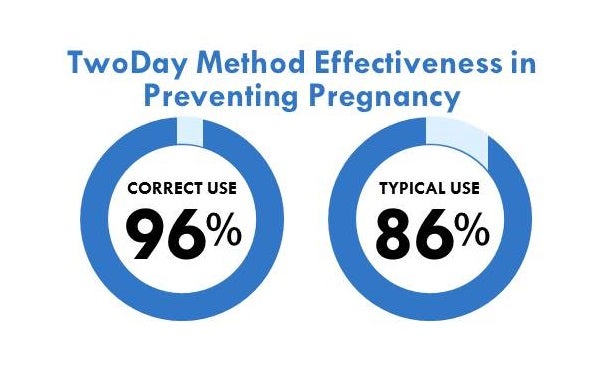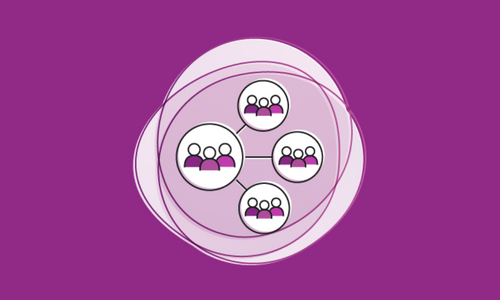TwoDay Method

TwoDay Method® is a fertility awareness method of family planning that uses cervical secretions to indicate fertility. A TwoDay Method user checks for cervical secretions at least twice a day. If they notice secretions of any type, color, or consistency either “today” or “yesterday,” today is considered a fertile day. A simple card is used to note observations and keep track of the days with secretions.
Secretions are a reliable indicator of fertility. When a woman has cervical secretions, she is potentially fertile and can become pregnant from unprotected intercourse. TwoDay Method appeals to women who want to use a hormone-free method regardless of cycle length. The TwoDay Method was developed for women interested in a natural approach that relies on their body’s signs and symptoms of fertility.
Effectiveness

An efficacy trial found the TwoDay Method was more than 96% effective in preventing pregnancy with correct use. That means that out of 100 women using the method for one year, fewer than four of them would get pregnant if they used the TwoDay Method correctly. With typical use, it is more than 86% effective. These efficacy rates are similar to those of other user-directed methods.
How does TwoDay Method work?
- A user checks for secretions at least twice daily as soon as her menstrual bleeding stops. Secretions are anything coming from the vagina, except menstrual bleeding.
- Moisture can be felt at the opening of her vagina or secretions can be noticed on toilet paper, her underpants, or her fingers.
- Secretions generally start a few days after her period stops. Once secretions start they continue for several days in a row followed by days without secretions.
- If no secretions are noticed today AND yesterday (two consecutive days without secretions), pregnancy is unlikely today.
- If no secretions are noticed either today OR yesterday, pregnancy is likely today. Avoid unprotected sex today to avoid pregnancy.
Useful facts | Secretions have several key functions:
- Secretions make it possible for sperm to live up to five days in a person’s reproductive track. Without secretions, the acidic environment of the vagina will cause the sperm to deteriorate quickly.
- When cervical secretions are very fluid (more watery, around the day of ovulation), they serve as a medium for the sperm to navigate into the uterus. This fluidity allows the secretions to flow down the vaginal walls making them easily noticeable for the woman at the opening of her vagina or vulva.
- When secretions have little water content (on the infertile days), they form a sticky plug at the opening of the cervix, which is impenetrable by sperm. With less water content, secretions do not flow down and are not noticeable.
Who can use it?
A user can start TwoDay Method right away if both method criteria are met: 1) the user has healthy secretions and 2) with a partner can use condoms or not have sex on fertile days.
Programs interested in adding TwoDay Method to their method mix can refer to the key resources below for guidance.
Key Resources
Visit the TwoDay Method Resource Repository for a complete listing of resources for program managers, providers, and policymakers.
Evidence & Research
Interested in the evidence behind this method? See the collection of peer reviewed journal articles published about the TwoDay Method here. Peer-reviewed journal articles are labeled “Journal Articles” in the search results.
TwoDay Method Services: Quick start approach
Requiring that a client waits until the onset of menses before they initiate a family planning method is a medical barrier that could result in unintended pregnancies. Hence, a quick-start approach to TwoDay Method service delivery was tested. 167 women in Peru were counseled in TwoDay Method use (regardless of cycle day) and followed for up to seven months. No significant differences were observed in correct use, continuation rates, and acceptability of the method between women who were counseled at different points in the cycle. These findings suggest that women can be taught and successfully learn to use the method at any time in their menstrual cycle. Read Journal Article
Implications of some traditional practices for TwoDay Method use
Female genital cutting and other traditional vaginal practices are still highly prevalent in parts of Africa and elsewhere. Health consequences and side effects of these practices may influence the presence and appearance of cervical secretions, which may affect the efficacy and acceptability of the TwoDay Method. Yet many of the countries where these practices are prevalent also have low contraceptive use, high rates of unmet need for family planning, and resource constraints at individual and country levels that result in limited access and availability of contraceptive commodities and may, therefore, benefit from TwoDay Method service introduction. The protocol for offering the method includes an explanation of normal patterns of the presence or absence of secretions, and may need to be modified to include the possible effects of these traditional practices on method use. Given the potential challenges and possibilities of offering TwoDay Method services in areas where women have been subjected to female genital cutting and other traditional vaginal practices, studies to explore the feasibility and acceptability of the method in these areas should also explore the possible impact on the effective use of the TwoDay Method, and carefully document the cultural, sexual, and gender-related influences of these practices as they relate to TwoDay Method use. Read Journal Article
 Where We Work
Where We Work  Press Room
Press Room  FACT Project
FACT Project  Passages Project
Passages Project  Learning Collaborative
Learning Collaborative  Search All Resources
Search All Resources  Social Norms
Social Norms  Fertility Awareness Methods
Fertility Awareness Methods 